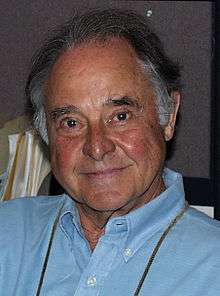John Chowning

John M. Chowning (/ˈtʃaʊnɪŋ/; born August 22, 1934 in Salem, New Jersey) is an American composer, musician, inventor, and professor best known for his work at Stanford University and his invention of FM synthesis while there.
Contribution
Chowning is known for having discovered the FM synthesis algorithm in 1967.[1] In FM (frequency modulation) synthesis, both the carrier frequency and the modulation frequency are within the audio band. In essence, the amplitude and frequency of one waveform modulates the frequency of another waveform producing a resultant waveform that can be periodic or non-periodic depending upon the ratio of the two frequencies.
Chowning's breakthrough allowed for simple—in terms of process—yet rich sounding timbres, which synthesized 'metal striking' or 'bell like' sounds, and which seemed incredibly similar to real percussion. (Chowning was also a skilled percussionist.) He spent six years turning his breakthrough into a system of musical importance and eventually was able to simulate a large number of musical sounds, including the singing voice. In 1974 Stanford University licensed the discovery to Yamaha in Japan (Mattis 2001), with whom Chowning worked in developing a family of synthesizers and electronic organs. This patent was Stanford's most lucrative patent at one time, eclipsing many in electronics, computer science, and biotechnology.
The first commercial musical instrument to incorporate FM Synthesis was the Synclavier® I, introduced by New England Digital Corporation in 1977. Their Synclavier® II, introduced in 1980, was frequently used in the production of popular music beginning that year. The first Yamaha product to incorporate the FM algorithm was their GS1, a digital synthesizer that first shipped in 1981. Some thought it too expensive at the time, Chowning included. Soon after, in 1983, Yamaha made their first commercially successful digital FM synthesizer, the DX7.
Another important aspect of Chowning's work is the simulated motion of sound through physical space. In 1972 he was first able to create the illusion of a continuous 360-degree space using only four speakers, in his composition Turenas (Mattis 2001).
Early life
Chowning graduated from Wittenberg University with a Bachelor of Music in 1959 (Nelson 2015, ). He studied music composition for two years (1959–61) with Nadia Boulanger in Paris and received his PhD in 1966 from Stanford, where he studied under Leland Smith. He was the founding director in 1975 of the Center for Computer Research in Music and Acoustics (CCRMA) at Stanford University (Mattis 2001).
Chowning also worked for a number of years at IRCAM, in Paris.
Private life
Chowning married Elisabeth Keller and they had two children, John and Marianne. Both John and Marianne had two children, Jade, Sam, Madeline, and Evan. John's second marriage is to Maureen (Doody) Tiernay and they had one child named James Scott.
Famous compositions
One of Chowning's most famous pieces is called Stria (1977). It was commissioned by IRCAM for the Institute's first major concert series called Perspectives of the 20th Century. His composition was noted for its inharmonic sounds due to his famous FM algorithm and his use of the golden mean (1.618...) in music.
Other famous compositions include Turenas (1972), which was one of the first electronic compositions to have the illusion of sounds moving in a 360-degree space (Tyranny n.d.). With Phoné (1980–1981), he became the first to put FM over voice synthesis (Anon. 2001).
Compositions
- Sabelithe, 1966, revised 1971
- Turenas, 1972
- Stria, 1977
- Phoné, 1980–1981
- Voices, 2005
See also
- CCRMA — Center for Computer Research in Music and Acoustics
- Frequency modulation synthesis
- John M. Chowning Papers
References
- Anon. 2001. "Artificial Voice", translated by Niiki Halpern. Ircam Centre Pompidou archive from 15 July 2007, accessed 26 March 2015).
- Mattis, Olivia. 2001. "Chowning, John M(acLeod)". The New Grove Dictionary of Music andMusicians, second edition, edited by Stanley Sadie and John Tyrrell. London: Macmillan Publishers.
- Nelson, Andrew J. 2015. The Sound of Innovation: Stanford and the Computer Music Revolution. Cambridge, MA: MIT Press.
- Tyranny, "Blue" Gene. n.d.. "Review: John Chowning: Phone [sic] (1980–1981) / Turenas (1972) / Stria (1977)/ Sabelithe (1971)". Allmusic website (accessed 26 March 2015).
Further reading
- Baudouin, Olivier, Pionniers de la musique numérique, Sampzon, Delatour, 2012.
- John Chowning. Portraits polychromes. P.A. Castanet, É. Gayou, J.C. Risset et al. (eds). Paris: Ina – Michel de Maule, 2005.
- Computer Music Journal (The Reconstruction of Stria), Computer Music Journal, Fall 2007, Vol. 31.
- Roads, C., “John Chowning on composition”, Composers and the computer. Los Altos CA: Kaufman, pp. 18–25, 1985.
- Zelli, Bijan. “Interview with John Chowning.” [www.bijanzelli.com/Chowning_Interview_Published.pdf] (April 2010). Montréal: CEC.
- Zelli, Bijan. “Reale und virtuelle Räume in der Computermusik: Theorien, Systeme, Analysen.” Unpublished PhD dissertation. Kommunikations- und Geschichtswissenschaft, Technische Universität Berlin, 2001. Available on the author’s website, the dissertation includes an analysis of Turenas. (German)
External links
- "biography" (in French). IRCAM.
- Chaiken, Alison and Ann Arbor. Interview with John Chowning (audio). 13 April 2006.
- Portraits Polychromes, John Chowning, INA (Institut National Audiovisuel).
- Interview with John Chowning (2015) charting a historical overview of the different branches of his artistic career, focusing on his interest in the human voice, the creation of new sonorities, and being a pioneer in a discipline at a time when using computers to generate music was a leap into the void between creative eccentricity and scientific adventure.
